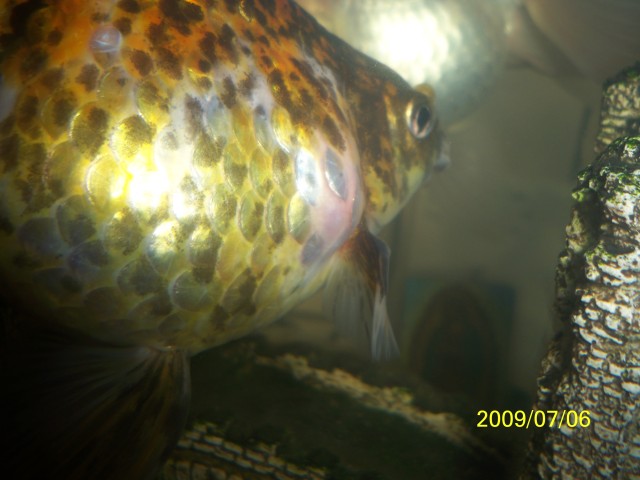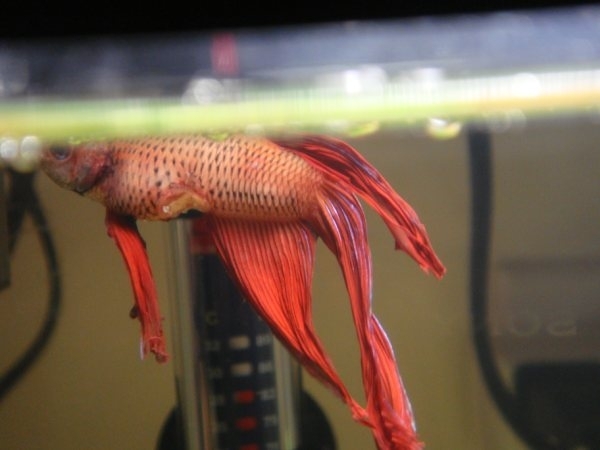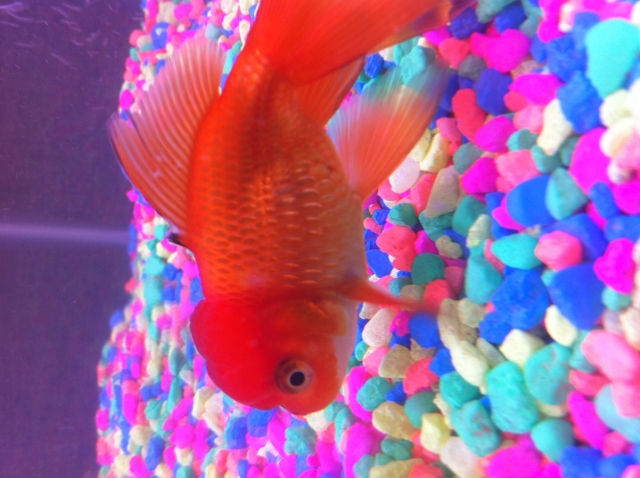QuestionQUESTION: I've had my 10 gallon tank for 11 months. I currently have 2 guppies male and female and 2 platies male and female. All four fish were bought the weekend after Christmas. I have 2 breeds of algae eaters(minature and the other looks part tiger, part shark and is a lot bigger) and one frog. I have a dispsable carbon filter. (I recently decided to clean the current filter weekly and replace it monthly) I've never tested the level of the ph, ammonia or nitrite in the water. I change the water once a month and a little more than half the water is replaced. A tap water conditioner is added to the water. I have followed the advice of friends and family who had experience with fish tanks. Please advise me of any thing I should do differently. Especially since there are babies on the way.
Until recent I thought platies laid egss. Only because I actually saw a previous platy have her eggs spray out of her. They were perfectly round and there were no dark centers or tails and no wiggly babies.
I have a pregnant guppy and a pregnant platy. I see more blacks spots near the guppy's tail,but on one side of her body that appears larger some days. Why does the black area appear to change? She may have a week or two left till she gives birth. My platy maybe be due around the same time it seems, but I don't see many black spot towards her tail. Her babies toward the tail are yellow and clear. When she swims away from me,I see a dark centers in the babies closer to her head. I have a 3 way breeder tank. How soon should I put them in the breeder tank and how will I know when they are too stressed in the breeder tank? Is a 3 way breeder big enough for amount of babies I've heard they both can have? How warm should the water be for the mothers? It currently ranges from 70 to 72.
Also I've had platies in the past to die of a possible bacteria infection that I just recently learned about. What happens is that they would stop eating appear white on certain areas of their body, their scales appear to fluff up, then the fish dies. What is it and how can I correct this? Also my pregnant platy has a white spec on her side and tail fin, but she's alert and eating. Is it possible that now she is it also?
ANSWER: Hi Cantis;
The white patches could be something like columnaris infection. It is a very serious bacterial infection that often leads to death. Once an infection is established they need antibiotic treatment. If the white on your fish looks more like salt specks, it's probably a parasite called "ich". You can get medication for it from the fish store.
The best weapon against any disease is to avoid illness in the first place by keeping the immune system strong. We do this by providing good water quality and consistent temperature. A month is a long time for your tank to go between water changes. Replacing 50% at a time is pretty stressful too. All tanks should have a weekly water change but no more than 25% at a time. Livebearers such as your guppies and platies especially need frequent changes. Commercial breeders of these types of fish actually change part of their water every day. It keeps them strong and helps the babies to grow fast and strong. To get things back in order for them and improve water quality it's okay to do a 25% water change every couple of days for a week or so. Then you can do a weekly change from there on. Hopefully your fish won't develop the white patches anymore. Their immune systems will be stronger and their overall health will be better.
It is best not to replace your filter pads unless they are literally falling apart. Whenever you make a water change just swish the filter pads around in the bucket of dirty water you removed from the tank. This will clear the pads without destroying the beneficial bacterial colonies clinging to them that your fish need. I have some filter media that I have been using for over 2 years in my filters.
When a livebearing fish looks like they are laying eggs, it means they are basically having a 'miscarriage'. The babies aren't mature and for some reason can't be carried to term. It happens sometimes. The main cause is usually stress, and water quality can play a major part in that too.
One cause of stress in female guppies and female platies is when there are not enough females per male. There really should be at least two females for every male. Males can get pretty "amorous" and want to breed all the time. It can really stress a single lone female and she never gets a break from his attention. With extra females to distract him they can each get a little bit of a break. The problem for your tank though is that it is too small for very many more fish. You could get maybe one more female guppy and one more female platy.
When your females eat there will be a change in how their gravid spot looks. Then when they have a bowel movement it will change again. You will know they are close to delivery when they hide more and their belly takes on a boxy shape. The bottom and sides will be a bit flattish. I personally don't like the breeder traps. They are very stressful for fish. Too small and lacking a place to hide they just aren't a good place for a pregnant female, babies, or any fish for that matter, in my opinion. They are only good for a temporary emergency holding pen. Only for a couple of days until another tank can be made available. The best thing for you to do would be to set up a nursery maternity tank for birthing. Move the females over there for a couple of weeks to let them have their babies. You don't want to move them when they are close to delivery and show signs of readiness. It could shock them into a premature delivery. Move the females out again a few hours after they deliver. They don't start trying to eat babies until about 12 hours after delivery.
Don't put any gravel or rocks in the bottom of the nursery tank. Babies can get caught in there and babies require frequent small feedings so food will get stuck in it and foul the water. Stock your nursery with lots of fluffy live plants for the babies to hide in and eat off of. Weigh some of the bunches of plants down so some stay near the bottom. Little plant weights are available at fish stores. Some plants come with them already attached. The baby fish really like the microscopic organisms that grow on the plants too.
For a filter in the nursery, use a sponge filter operated by an air pump. It has slow flow and won't hurt the babies if they get near it. Other filters will suck them up and possibly kill them. (Yikes.) Get the sponge filter started right away so it has time to get beneficial bacteria growing on it before you put fish in the tank. Then, put a pinch of fish food in there every day. Yes, even without fish the tank needs food so the beneficial bacteria will grow and make it safe for a small population of fish. The beneficial bacteria need ammonia to feed on and the fish food will provide that as it decays. The live plants will bring in some beneficial bacteria to "seed" your system and help get it started. The beneficial bacteria eventually grows colonies that cling to all tank surfaces including the glass. It processes fish wastes.
Good luck...
I hope your fish do better and you have lots of lively wiggly babies very soon!
At Your Service;
Chris Robbins
---------- FOLLOW-UP ----------
QUESTION: I did a 25 percent change the day I sent you the e-mail, because I found a similar question and answer to the one I asked you.
I don't know how much the medication cost for the fish that has ich. If I can't get it right away, then what are chances for survival?
What should the water temperature be for the mothers or all the fish?
I know my tank is small so planned on giving away most of the babies when they are mature enough.
I don't have the resources or space to buy and set up separate tank. So it looks like I will be using the 3 way breeder. How soon should I put them in the breeder? What is their survival rate if you recommend that I put them in now? Is there a way for me to make the breeder tank less stressful for them (Plant it black on one side,put a plastic plant in it or buy the net breeder)? How will I know when their numerous birthing process is over?
Thank you for your time.
AnswerHi Cantis;
Ich has to be treated right away. It will get out of hand very quickly if it is allowed to reproduce.
Fancy guppies and platies will both do okay at a water temperature of about 72f. To treat ich it must be raised to at least 80f, 82f is better.
When females start to act pretty normal after having babies they are probably done.
The breeder is just not going to be large enough no matter what you do with it. The net type isn't any better really. You could put in a tiny sprig of plant to help her hide but it's still a very stressful and compact place for her to be.
Your females are going to have more babies every few weeks before the ones already in the breeder are large enough to release into the tank. It's probably best to just let the birthing occur in the tank and provide more plants for the babies to hide in. The adults will eat some of them but that's okay. The smartest, strongest and quickest will survive to pass on their genes to the next generation. That's how it works in nature so that stronger fish are produced.
Your tank is just not large enough for the hundreds of babies that are to come, even temporarily until they get big enough to give away. You will probably have to give away some pretty small fish to even begin to make that work, as well as make more water changes every week. Otherwise your tank is going to get too overcrowded very quickly.
Good luck...
At Your Service;
Chris Robbins

 my goldfish has a red lump
Question
red bump on side of my
hi im joanna and I just
my goldfish has a red lump
Question
red bump on side of my
hi im joanna and I just
 Betta with open wound
Question
Betta wound
Ive had my red betta (Ronin) for t
Betta with open wound
Question
Betta wound
Ive had my red betta (Ronin) for t
 Sucky Fish with white fuzz
Question
sucky fish with white
I have a 30 gallon tank
Sucky Fish with white fuzz
Question
sucky fish with white
I have a 30 gallon tank
 Something wrong with my red cap oranda and dont know whats causing it
QuestionQUESTION: Hi,
I have a two inch or
Something wrong with my red cap oranda and dont know whats causing it
QuestionQUESTION: Hi,
I have a two inch or
 Ahli Cichlid
QuestionWhite Fish
QUESTION: Why is my Electric
Ahli Cichlid
QuestionWhite Fish
QUESTION: Why is my Electric